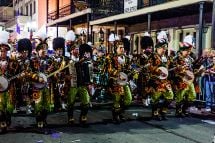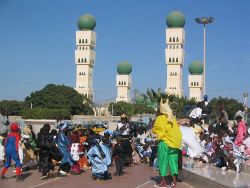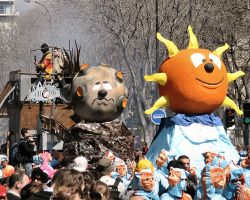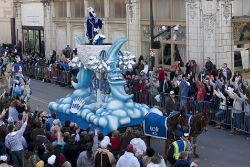Mardi Gras
| Mardi Gras | |
|---|---|

| |
| Celebrations in New Orleans, Louisiana, U.S. | |
| Also called | Fat Tuesday, Shrove Tuesday, Pancake Tuesday |
| Type | Christian, Cultural |
| Significance | Celebration period before fasting season of Lent |
| Date | Day before Ash Wednesday, 47 days before Easter |
| Celebrations | Parades, parties |
| Related to | Shrove Tuesday, Carnival, Shrove Monday, Shrovetide, Ash Wednesday, Lent, Užgavėnės, Maslenitsa, |
Mardi Gras, or Fat Tuesday, refers to events of the Carnival celebration, beginning on or after the Christian feasts of the Epiphany (Three Kings Day) and culminating on the day before Ash Wednesday, which is the beginning of Lent. Mardi Gras is French for "Fat Tuesday", reflecting the practice of the last night of eating rich, fatty foods before the ritual Lenten sacrifices and fasting of the Lenten season. In countries such as the United Kingdom, Mardi Gras is also known as Shrove Tuesday, associated with Shrovetide celebrations before the fasting and religious obligations associated with the penitential Lenten season.
Description
Mardi Gras, or Fat Tuesday, refers to events of the Carnival celebration, beginning on or after the Christian feasts of the Epiphany (Three Kings Day) and culminating on the day before Ash Wednesday. Mardi Gras is French for "Fat Tuesday," reflecting the practice of the last night of eating rich, fatty foods before the ritual Lenten sacrifices and fasting of the Lenten season. This it is the last day of "fat eating" or "gorging" before the fasting period of Lent.[1] Carnival translates as "farewell to meat": Carnias in carnivorous, and vale as in valediction, valedictorian, etc.[2] As this is the last day of the Christian liturgical season historically known as Shrovetide, before the penitential season of Lent, related popular practices, such as indulging in food that one might give up as their Lenten sacrifice for the upcoming forty days, are associated with the celebrations.
In countries such as the United Kingdom, Mardi Gras is known as Shrove Tuesday, which is derived from the word shrive, meaning "to administer the sacrament of confession to; to absolve."[1] Shrove Tuesday is observed by many Christians, who "make a special point of self-examination, of considering what wrongs they need to repent, and what amendments of life or areas of spiritual growth they especially need to ask God's help in dealing with."[2] As the day before the beginning of Lent, Shrove Tuesday is observed in many Christian countries through participating in confession and absolution, the ritual burning of the previous year's Holy Week palms, finalizing one's Lenten sacrifice, as well as eating pancakes and other sweets.[3] Many Christian congregations thus observe the day through the holding of pancake breakfasts, as well as the ringing of church bells to remind people to repent of their sins before the start of Lent.[3]
On Shrove Tuesday, churches also burn the palms distributed during the previous year's Palm Sunday liturgies to make the ashes used during the services held on the very next day, Ash Wednesday.[4]
History
The tradition of marking the start of Lent has been documented for centuries. Ælfric of Eynsham's "Ecclesiastical Institutes" from around 1000 C.E. states: "In the week immediately before Lent everyone shall go to his confessor and confess his deeds and the confessor shall so shrive him as he then may hear by his deeds what he is to do [in the way of penance]."[5] By the time of the late Middle Ages, the celebration of Shrovetide lasted until the start of Lent.[6] It was traditional in many societies to eat pancakes or other foods, such as fasnachts and pączki, made with the butter, eggs, and fat that would be given up during the Lenten season. The specific custom of British Christians eating pancakes on Shrove Tuesday dates to the sixteenth century.[7]
Traditions
The festival season varies from city to city, as some traditions, such as the one in New Orleans, Louisiana, consider Mardi Gras to stretch the entire period from Twelfth Night (the last night of Christmas which begins Epiphany) to Ash Wednesday.[8] Others treat only the final three-day period before Ash Wednesday as the Mardi Gras.[9] In Mobile, Alabama, Mardi Gras–associated social events begin in November, followed by mystic society balls on Thanksgiving,[10] then New Year's Eve, followed by parades and balls in January and February, celebrating up to midnight before Ash Wednesday.
Mardi Gras as part of Carnival is also an important celebration in various Anglican and Catholic European nations.[1]

Czech Republic
In the Czech Republic it is a folk tradition to celebrate Mardi Gras, which is called Masopust (meat-fast). There are celebration in many places including Prague[11] but the tradition also prevails in the villages such as Staré Hamry, whose the door-to-door processions there made it to the UNESCO World Intangible Cultural Heritage List.[12]
Germany
The celebration on the same day in Germany knows many different terms, such as Schmutziger Donnerstag or Fetter Donnerstag (Fat Thursday), Unsinniger Donnerstag, Weiberfastnacht, Greesentag and others, and are often only one part of the whole carnival events during one or even two weeks before Ash Wednesday be called Karneval, Fasching, or Fastnacht among others, depending on the region. In standard German, schmutzig means "dirty", but in the Alemannic dialects schmotzig means "lard" (Schmalz), or "fat";[13] "Greasy Thursday", as remaining winter stores of lard and butter used to be consumed at that time, before the fasting began. Fastnacht means "Eve of the Fast", but all three terms cover the whole carnival season. The traditional start of the carnival season is on 11 November at 11:11 am (11/11 11:11).
Italy
In Italy Mardi Gras is called Martedì Grasso (Fat Tuesday). It's the main day of Carnival along with the Thursday before, called Giovedí Grasso (Fat Thursday), which ratifies the start of the celebrations. The most famous Carnivals in Italy are in Venice, Viareggio and Ivrea. Ivrea has the characteristic "Battle of Oranges" that finds its roots in medieval times. The Italian version of the festival is spelled Carnevale.[14]
Sweden
In Sweden the celebration is called Fettisdagen, when you eat fastlagsbulle, more commonly called Semla. The name comes from the words "fett" (fat) and "tisdag" (Tuesday). Originally, this was the only day one should eat fastlagsbullar.[15]
United States
While not observed nationally throughout the United States, a number of traditionally ethnic French cities and regions in the country have notable celebrations. Mardi Gras arrived in North America as a French Catholic tradition with the Le Moyne brothers,[16] Pierre Le Moyne d'Iberville and Jean-Baptiste Le Moyne de Bienville, in the late 17th century, when King Louis XIV sent the pair to defend France's claim on the territory of Louisiane, which included what are now the U.S. states of Alabama, Mississippi, Louisiana and part of eastern Texas.[16]
The expedition, led by Iberville, entered the mouth of the Mississippi River on the evening of 2 March 1699 (new style), Lundi Gras. They did not yet know it was the river explored and claimed for France by René-Robert Cavelier, Sieur de La Salle in 1683. The party proceeded upstream to a place on the east bank about 60 miles (100 km) downriver from where New Orleans is today, and made camp. This was on 3 March 1699, Mardi Gras, so in honour of this holiday, Iberville named the spot Point du Mardi Gras (French: "Mardi Gras Point") and called the nearby tributary Bayou Mardi Gras.[17] Bienville went on to found the settlement of Mobile, Alabama in 1702 as the first capital of French Louisiana.[18] In 1703 French settlers in Mobile established the first organised Mardi Gras celebration tradition in what was to become the United States.[16][19][20][21] The first informal mystic society, or krewe, was formed in Mobile in 1711, the Boeuf Gras Society.[19] By 1720, Biloxi had been made capital of Louisiana. The French Mardi Gras customs had accompanied the colonists who settled there.[16]
In 1723, the capital of Louisiana was moved to New Orleans, founded in 1718.[18] The first Mardi Gras parade held in New Orleans is recorded to have taken place in 1837. The tradition in New Orleans expanded to the point that it became synonymous with the city in popular perception, and embraced by residents of New Orleans beyond those of French or Catholic heritage. Mardi Gras celebrations are part of the basis of the slogan Laissez les bons temps rouler ("Let the good times roll").[16]{{ safesubst:#invoke:Unsubst||date=__DATE__ |$B=
}} On Mardi Gras Day, the Tuesday before Ash Wednesday, the last parades of the season wrap up and the celebrations come to a close with the Meeting of the Courts (known locally as the Rex Ball). Other cities along the Gulf Coast with early French colonial heritage, from Pensacola, Florida; Galveston, Texas; to Lake Charles and Lafayette, Louisiana; and north to Natchez, Mississippi and Alexandria, Louisiana, have active Mardi Gras celebrations.
Galveston's first recorded Mardi Gras celebration, in 1867, included a masked ball at Turner Hall (Sealy at 21st St.) and a theatrical performance from Shakespeare's "King Henry IV" featuring Alvan Reed (a justice of the peace weighing in at 350 pounds!) as Falstaff. The first year that Mardi Gras was celebrated on a grand scale in Galveston was 1871 with the emergence of two rival Mardi Gras societies, or "Krewes" called the Knights of Momus (known only by the initials "K.O.M.") and the Knights of Myth, both of which devised night parades, masked balls, exquisite costumes and elaborate invitations. The Knights of Momus, led by some prominent Galvestonians, decorated horse-drawn wagons for a torch lit night parade. Boasting such themes as "The Crusades," "Peter the Great," and "Ancient France," the procession through downtown Galveston culminated at Turner Hall with a presentation of tableaux and a grand gala.
In the rural Acadiana area, many Cajuns celebrate with the Courir de Mardi Gras, a tradition that dates to medieval celebrations in France.[22]
St. Louis, Missouri, founded in 1764 by French fur traders, claims to host the second largest Mardi Gras celebration in the United States.[23] The celebration is held in the historic French neighborhood, Soulard, and attracts hundreds of thousands of people from around the country.[24] Although founded in the 1760s, the St. Louis Mardi Gras festivities only date to the 1980s.[25] The city's celebration begins with "12th night," held on Epiphany, and ends on Fat Tuesday. The season is peppered with various parades celebrating the city's rich French Catholic heritage.[26]
After the French-Indian War Louisiana was ceded to Spain in the Treaty of Paris of 1763.[27] With this change in leadership over the region, Madi Gras celebration began to be put to a halt. People of color were prohibited from wearing masks, feathers, and attending night time balls, all actions indicative of Mardi Gras celebrations.[28] They continued to form organizations in which they celebrated, however.[29] The high society balls that used to be held in French Louisiana were also put to a stop in this time period.[30] This is when Madi Gras celebrations began to be seen in a negative light in North America, which eventually led to the Mardi Gras Act of 1875.
The Louisiana purchase granted a total of around 827,000 square miles of land to the United States for around 15 million dollars.[31] Taking place in 1803, ownership of the land around New Orleans had changed three times within a 105-year time span. Under early American rule, rules implemented by the Spanish continued to be upheld, like banning masked balls and public disguises.[32] After a major slave revolt in 1811, and the rise of a popular belief that spies for Aaron Burr were using masks as disguises, regulations got more intense.[33][34] Because of these regulations, people of color (both of African and Native American descent) began to form Krewes in which they would organize their own celebrations (they are still in operation and help to organize the parade and other celebrations today).[35] As time went on, Creoles and other members of the New Orleans community were able to convince the American Government to reinstate the balls in 1823 and later in 1827 make masking on the street legal. In 1841, the first formal parade in celebration of Mardi Gras was held. During the Civil War float building was prohibited, but people continued to march on foot in celebration.[36] Finally, with the passing of this act, Mardi Gras became a legal holiday in the state of Louisiana.[37]
In 1875, the Louisiana State Legislature declared Mardi Gras a legal holiday in the state of Louisiana.[38] The holiday is observed on the day before Ash Wednesday (also known as Fat Tuesday). [39][40][41]
Establishing the state holiday made it possible for people to celebrate Mardi Gras legally, including suspending laws against concealing one's identity with a mask for the day, though it continues to be illegal on every other day of the year.[42] Critics maintain that this holiday has facilitated anonymity which has led to unabashed drunkenness, drug abuse, violence against individuals and businesses, and other criminal activity.
Costumes
Mardi Gras, as a celebration of life before the more-somber occasion of Ash Wednesday, nearly always involves the use of masks and costumes by its participants. In New Orleans, for example, these often take the shape of fairies, animals, people from myths, or various Medieval costumes[43] as well as clowns and Indians (Native Americans).[44] However, many costumes today are simply elaborate creations of colored feathers and capes. Unlike Halloween costumery, Mardi Gras costumes are not usually associated with such things as zombies, mummies, bats, blood, and the like, though death may be a theme in some. The Venice tradition has brought golden masks into the usual round of costumes.[45]
Notes
- ↑ 1.0 1.1 1.2 Melitta Weiss Adamson and Francine Segan (eds.), Entertaining from Ancient Rome to the Super Bowl (Greenwood, 2008, ISBN 978-0313339578).
- ↑ 2.0 2.1 Darren Provine, Shrove Tuesday Retrieved September 15, 2020.
- ↑ 3.0 3.1 Alfred Heneage Cocks, The Church Bells of Buckinghamshire: Their Inscriptions, Founders, and Uses, and Traditions (Arkose Press, 2015, ISBN 978-1344077897).
- ↑ Mary Farrow, Where do Ash Wednesday ashes come from? Catholic News Agency, March 2, 2019. Retrieved September 15, 2020.
- ↑ Shrovetide Catholic Encyclopedia. Retrieved September 15, 2020.
- ↑ David Self, One Hundred Readings for Assembly (Heinemann Educational Books, 1993, ISBN 978-0435800413).
- ↑ Tony Collins, John Martin, and Wray Vamplew (eds.), Encyclopedia of Traditional British Rural Sports (Routledge, 2005, ISBN 978-0415352246).
- ↑ John Wilds, Charles L. Dufour, and Walter G. Cowan, Louisiana, Yesterday and Today: A Historical Guide to the State (Louisiana State University Press, 1996, ISBN 978-0807118924).
- ↑ Dennis Bratcher, {{cite web|url=http://www.crivoice.org/cylent.html The Season of Lent Christian Resource Institute, 2018. Retrieved September 15, 2020.
- ↑ "Mobile Carnival Association, 1927", MardiGrasDigest.com, 2006, webpage: mardigrasdigest-Mobile Archived copy.
- ↑ Mardi Gras in Bohemia-Prague. Retrieved 18 January 2016.
- ↑ Staročeský masopust Hamry.
- ↑ "Woher hat der Schmutzige Donnerstag seinen Namen?", 17 February 2013. Retrieved 7 February 2015. (written in German)
- ↑ Killinger, Charles L. (2005). Culture and Customs of Italy (in en). Greenwood Publishing Group. ISBN 978-0313324895. “mardi gras in italy.”
- ↑ Swedish semla: more than just a bun. Sweden.se. Archived from the original on 6 June 2011. Retrieved 22 February 2011.
- ↑ 16.0 16.1 16.2 16.3 16.4 "New Orleans & Mardi Gras History Timeline " (event list), Mardi Gras Digest, 2005, webpage: MG-time {{#invoke:webarchive|webarchive}}
- ↑ "9 Things You May Not Know About Mardi Gras", History.com.
- ↑ 18.0 18.1 "Timeline 18th Century:" (events), Timelines of History, 2007, webpage: TLine-1700-1724: on "1702–1711" of Mobile.
- ↑ 19.0 19.1 Carnival/Mobile Mardi Gras Timeline. Museum of Mobile. Museum of Mobile. Retrieved 18 July 2012.
- ↑ "Mardi Gras in Mobile" (history), Jeff Sessions, Senator, Library of Congress, 2006, webpage: LibCongress-2665.
- ↑ "Mardi Gras" (history), Mobile Bay Convention & Visitors Bureau, 2007, webpage: MGmobile.
- ↑ Barry Jean Ancelet (1989). Capitaine, voyage ton flag : The Traditional Cajun Country Mardi Gras. Center for Louisiana Studies, University of Southwestern Louisiana. ISBN 0-940984-46-6.
- ↑ Geiling, Natasha, "Best Places to Celebrate Mardi Gras Outside of New Orleans", Smithsonian. (written in en)
- ↑ Houser, Dave G., "7 big Mardi Gras celebrations (not in New Orleans)", chicagotribune.com. (written in en-US)
- ↑ Mardi Gras in St. Louis' Soulard Neighborhood.
- ↑ 12th Night | Soulard Mardi Gras 2018 (in en).
- ↑ Editors, History com. French and Indian War (in en).
- ↑ The Mardi Gras Indians (in en).
- ↑ Mardi Gras History & Timeline (2010-11-24).
- ↑ Mardi Gras Galveston - A History.
- ↑ The Louisiana Purchase (in en).
- ↑ Greenspan, Jesse. 9 Things You May Not Know About Mardi Gras (in en).
- ↑ The Mardi Gras Indians (in en).
- ↑ Mardi Gras Galveston - A History.
- ↑ Greenspan, Jesse. 9 Things You May Not Know About Mardi Gras (in en).
- ↑ Mardi Gras Galveston - A History.
- ↑ Sparks, Randy (2007-05-08). “American Sodom: New Orleans Faces Its Critics and an Uncertain Future”. Nuevo Mundo Mundos Nuevos. Nouveaux mondes mondes nouveaux - Novo Mundo Mundos Novos - New world New worlds.
- ↑ Topic Guide to Mardi Gras: Significant Dates. Louisiana State University. Retrieved 15 January 2020.
- ↑ DOA 2020 Holidays. State of Louisiana. Retrieved 15 January 2020.
- ↑ Louisiana State Holidays. The Lunt Group.
- ↑ Sparks, Randy (2007-05-08). American Sodom: New Orleans Faces Its Critics and an Uncertain Future.
- ↑ Silverman, Leah (2019-03-01). 10 Things You Didn't Know About the History of Mardi Gras (in en-US).
- ↑ Lisa Gabbert (1999). Mardi Gras: A City's Masked Parade. The Rosen Publishing Group. ISBN 978-0-8239-5337-0.
- ↑ A Mardi Gras Dictionary. Pelican Publishing. ISBN 978-1-4556-0836-2.
- ↑ J.C. Brown (2008). Carnival Masks of Venice: A Photographic Essay. AAPPL Artists & Photographers Press, Limited. ISBN 978-1-904332-83-1.
ReferencesISBN links support NWE through referral fees
- Adamson, Melitta Weiss, and Francine Segan (eds.). Entertaining from Ancient Rome to the Super Bowl. Greenwood, 2008. ISBN 978-0313339578
- Cocks, Alfred Heneage. The Church Bells of Buckinghamshire: Their Inscriptions, Founders, and Uses, and Traditions. Arkose Press, 2015. ISBN 978-1344077897
- Collins, Tony, John Martin, and Wray Vamplew (eds.). Encyclopedia of Traditional British Rural Sports. Routledge, 2005. ISBN 978-0415352246
- Self, David. One Hundred Readings for Assembly. Heinemann Educational Books, 1993. ISBN 978-0435800413
- Wilds, John, Charles L. Dufour, and Walter G. Cowan. Louisiana, Yesterday and Today: A Historical Guide to the State. Louisiana State University Press, 1996. ISBN 978-0807118924
External links
All links retrieved
- Traditional Cajun Mardi Gras Celebrations
- Where to Celebrate Mardi Gras Around the World
- Fashion plates featuring historic Mardi Gras costumes from the Metropolitan Museum of Art Libraries
| |||||||
Credits
New World Encyclopedia writers and editors rewrote and completed the Wikipedia article in accordance with New World Encyclopedia standards. This article abides by terms of the Creative Commons CC-by-sa 3.0 License (CC-by-sa), which may be used and disseminated with proper attribution. Credit is due under the terms of this license that can reference both the New World Encyclopedia contributors and the selfless volunteer contributors of the Wikimedia Foundation. To cite this article click here for a list of acceptable citing formats.The history of earlier contributions by wikipedians is accessible to researchers here:
The history of this article since it was imported to New World Encyclopedia:
Note: Some restrictions may apply to use of individual images which are separately licensed.



